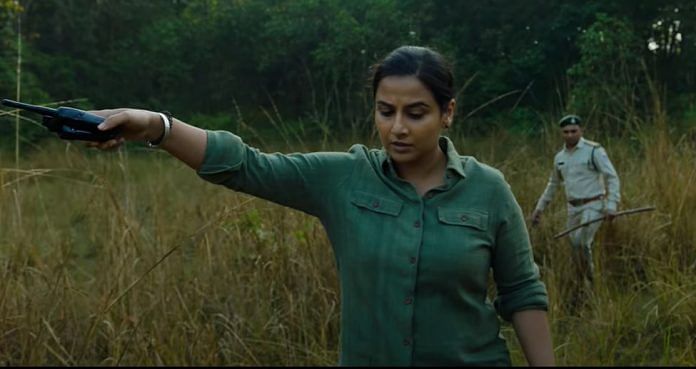Recently, I watched the movie Sherni starring Vidya Balan on Amazon Prime Video. Before you think this is a movie review where I sing praises of the direction, acting, or camera angles, know that I do not know anything about these. And if you think that this is a review where I hint about the importance of movies with female leadership, well, you are right. Female leadership needs encouragement because it is rational, as well as necessary. So, if you are here for the former, then fly away little bird. But stick around if you care about the increasing human-wildlife conflicts around us.
Set in deep rural India, Sherni is raw. It cuts open wounds we never knew existed and brings us band-aids that we had not heard of.
The characters in Sherni
There is a professor who finds happiness in helping animals and the forest department for thrills, not fame. He puts up plays in the form of folklore. He conducts tests to identify tiger DNA, and arrives whenever called upon.
Next, there is a forest department officer. She tries to handle, just like every other working woman in India, her work life and family life. And just like any other woman, she succeeds because women are made of stronger stuff. She takes practical decisions and gives clear instructions to her subordinates.
Dirty politics spoil the entire atmosphere of the village, and most of the villagers are too naïve to see through the games of the politicians.
There is also a young woman. She is vicious, intelligent and does not mince her words. She and her husband dream of better things for their daughter in education and sports. She is a headstrong woman, and her character is admirable.
Next, there are two officers, both corrupt, but have entirely different ways to craft corruption. These two officers are mirror images of many of us. Finally, there is, of course, the tigress Sherni.
Also read: 6 ‘missing’ Ranthambore tigers may have migrated for lack of space, field director says
Rural India to biodiversity
The movie highlights many issues. I will touch upon a few of them in this article.
Sherni clearly depicts how rural development has metamorphosised into vote bank politics and nothing more. The two contenders find ways to appease the villagers and end up causing destruction. This movie emphasises the role of local villagers in saving forests and biodiversity. The increasing number of changes that are being brought about for rural development is being done without the involvement of local communities. It portrays how irrational it is to make decisions about people’s lives without even asking them.
Now, you will ask me, so now the government has to go door to door asking for opinions? I will say, yes. It must do door-to-door surveys before announcing anything that relates to forests (or any other resource), local communities and people’s lives.
This is a world where human beings are not asked for opinions about their own lives, so it is obvious that Sherni will not be given her freedom. A set of human beings will decide her future.
In one, simple scene, the movie depicts how education can change the entire setting for rural India. A young boy explains the need for the Sherni and why she should not be murdered. The movie also showcases a glimpse of a seminar on the new Environmental Impact Assessment (EIA) law. Are EIA, SDG, CSR, ESG, and other such laws enough to ensure that environment and development go hand in hand? Because for a country like India, these terms are still very alien and may not even apply. The diversity in culture, resources, and people may not be captured by these abbreviations. I think we need a model specific to the Indian peninsula.
There is a scene where we see what mining in forests does to human and animal lives. Sherni cannot reach another forest because there is no other way than being airlifted. Finally, the movie shows a group of government-appointed people called “Forest Friends”. They are exactly what they sound like – local villagers helping save the forest.
Sherni ends in a perfect circle – the transfer of the officer, the arrival of a new officer, and the subordinates singing praises of the previous one while she walks around checking stuffed animals on display. Maybe that is what our lives will come to – the entire biodiversity of the country in a room, and tickets being sold for money.
Debashrita Dwivedy is a student of Dr B.R. Ambedkar School of Economics University, Bengaluru. Views are personal.






